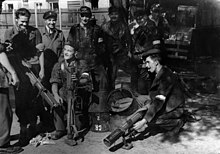PIAT
The Projector, Infantry, Anti Tank (PIAT) Mk I was a British man-portable anti-tank weapon developed during the Second World War.
The PIAT was designed in 1942 in response to the British Army's need for a more effective infantry anti-tank weapon and entered service in 1943.
The PIAT was based on the spigot mortar system, and projected (launched) a 2.5 pound (1.1 kg) shaped charge bomb using a cartridge in the tail of the projectile.
However, the device also had some disadvantages: powerful recoil, a difficulty in cocking the weapon, and early problems with ammunition reliability.
In November 1941 during Operation Crusader, part of the North African Campaign, staff officers of the British Eighth Army were unable to find even a single instance of a Boys knocking out a German tank.
The origins of the PIAT can be traced back as far as 1888, when an American engineer by the name of Charles Edward Munroe was experimenting with guncotton; he discovered that the explosive would yield a great deal more damage if there were a recess in it facing the target.
[2] Although the technology existed, it remained for British designers to develop a system that could deliver shaped charge ammunition in a larger size and with a greater range than that possessed by the No.
But he did not abandon the design, and eventually came up with the Blacker Bombard, a swivelling spigot-style system that could launch a 20-pound (9 kg) bomb approximately 100 yards (90 m).
Although the bombs it fired could not actually penetrate armour, they could still severely damage tanks, and in 1940 a large number of Blacker Bombards were issued to the Home Guard as anti-tank weapons.
[14] However, when the weapon was tested it proved to have a host of problems; a War Office report of June 1941 stated that the casing was flimsy and the spigot itself did not always fire when the trigger was pulled, and none of the bombs provided exploded upon contact with the target.
[1] Shortly after the trial of the Baby Bombard, Blacker was posted to other duties, and left the anti-tank weapon in the hands of a colleague in the department, Major Millis Jefferis.
[16] A warrant officer took the Shoulder Gun down to a firing range, aimed it at an armoured target, and pulled the trigger; the Shoulder Gun pierced a hole in the target, but also wounded the warrant officer when a piece of metal from the exploding round flew back and hit him.
[19] Churchill himself got involved in the argument; writing to the secretary of state for war in January 1943 he asked "Why should the name 'Jefferis shoulder gun' be changed to PIAT?
The moving spigot rod in the PIAT design was unusual, and served to help reduce recoil sufficiently to make it a viable shoulder fired weapon.
To prepare the weapon for firing the spigot mechanism, which was operated by a large spring, had to be cocked, and to do this was a difficult and awkward process.
[8][22] Tactical training emphasized that it was best used with surprise and concealment on the side of the PIAT team, and where possible enemy armoured vehicles should be engaged from the flank or rear.
[24] It was possible to use the PIAT as an ad-hoc crude mortar by placing the shoulder pad of the weapon on the ground and supporting it.
The Spigot mortar design allowed a large calibre powerful shaped charge bomb[8] giving greatly increased penetration power over the previous anti-tank rifles, allowing it to remain effective for the rest of the war; its construction was relatively simple and robust without a conventional barrel; there was no back-blast (unlike the contemporary American bazooka) that might endanger friendly troops and give the user's position away, this also meant that the PIAT could be used in confined spaces as in urban warfare; compared to the previous anti-tank rifles the muzzle blast was minimal, also a potential concealment issue.
Although the PIAT was theoretically able to penetrate approximately 100 millimetres (4 in) of armour, field experience during the Allied invasion of Sicily, which was substantiated by trials conducted during 1944, demonstrated that this capability was often nullified by problems of accuracy and round reliability.
During these trials, a skilled user was unable to hit a target more than 60% of the time at 100 yards (90 m), and faulty fuses meant that only 75% of the bombs fired detonated on-target.
[9] The PIATs' ammunition used the shaped charge principle, which, if the often unreliable early round design delivered it correctly to the target, allowed the warhead to penetrate almost all enemy armour types at close range.
[44] The Haganah and the emerging Israel Defence Force (IDF) used PIATs against Arab armour during the 1947–1949 Palestine war.
[46] The Indian Army was still using PIATs by the 1971 Indo-Pakistan war, they were used at the Battle of Longewala helping to halt the Pakistani armored division advance.







